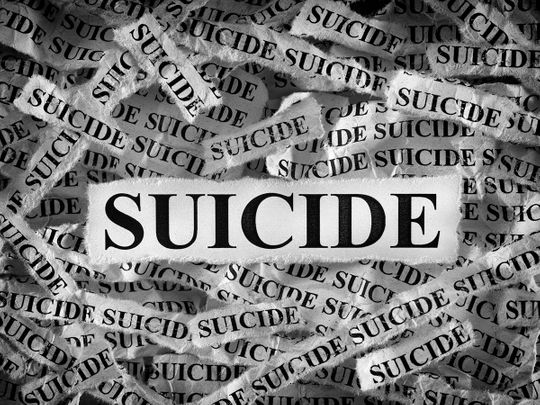Why is death becoming an escape route for many nowadays?
[ad_1]

Image Credit: i stock
Dubai: The passage from life to death has always fascinated human beings. But, when that allure drives people to take their own lives, many questions pop up: Is it the mystery that lies at the other side or the notion that death snuffs all pains of life that drives people to suicide?
Is death the end of all that we know as life? Philosophers, religious scholars and ethicist have offered various explanations. Well, so far no one has been to the other side and returned to state the facts.
There are instances of suicides from time past for what one might term trivial: Zeno, the found of Stoic school of philosophy, broke his toe and then died from holding his breath in 262 BC.
Though the end result is the same, a high-thinking philosopher’s reason for suicide is far removed from a common man’s and a mentally unstable person’s plunge into the unknown.
The rise of suicide deaths
As society evolved from BC to AD and modern times, suicides too increased at an alarming rate.
Some common denominators (for suicides) would be a deep struggle and despair in coping with the current situation, a loss of sense of self or feeling of isolation in tackling the issues…
– Dr Melanie C. Schlatter
With individualism and loneliness creeping into modern life, there has been a drastic rise in suicide deaths. According to last available data from World Health Organisation (WHO), there were an estimated 793,000 suicide deaths worldwide in 2016, which means an annual global age-standardised suicide rate of 10.5 per 100,000 population.
There is no one ‘real’ reason for suicides, said Dr Melanie C. Schlatter, Clinical Health Psychologist, Health Psychology UAE. “But some common denominators would be a deep struggle and despair in coping with the current situation, a loss of sense of self or feeling of isolation in tackling the issues, a sense of meaningless of life, and futility in efforts, a wish to escape from the thoughts and hardships being faced – death being one possible solution to end all the pain, and often a sense of burden to others.”
SOME RISK FACTORS FOR SUICIDE
Previous suicide attempt(s)
A history of suicide in the family
Substance misuse
Mood disorders (depression, bipolar disorder)
Access to lethal means (e.g., keeping weapons in the home)
Losses and other events (for example, the breakup of a relationship or a death, academic failures, legal difficulties, financial difficulties, bullying)
History of trauma or abuse
Chronic physical illness, including chronic pain
Exposure to the suicidal behavior of others
When that meaninglessness and sense of burden channel human thoughts into an escape route, suicide deaths become a reality. “I couldn’t see anything ahead. The feelings were burning a hole in me and this was a way out of that pain. The battle in my head was going to be over,” said a former patient of Dr Melanie C. Schlatter, who attempted and failed in her suicide attempt.
“I might have looked fine on the outside, but I was enveloped on the inside. I thought of a few ways to do it … and then those thoughts just stuck too. They seemed more appealing than anything else. I couldn’t think of my family anymore. I knew I loved them. I knew they loved me. But these thoughts of death just overshadowed everything. It was like a big wall separating me from everything I had once found solace in. Nothing was bringing me back to life anymore,” said the woman in her 30s who didn’t want to reveal her personal details.
‘I want to end the pain and suffering’
Most sufferers share similar views, as recounted by Dr Sreekumar V. Nair, Specialist Psychiatrist, Mediclinic Welcare Hospital, Dubai. “I want to end the pain and suffering. I can be free from all this if I die. I am a burden and trouble to everyone. I am not able to do anything. I am a total failure. Nobody can help me. There is no hope,” these are some of the statements from my patients with suicidal tendencies, said Dr Sreekumar V. Nair.
Looking at the patients I see, I would consider a combination of factors leading to suicide deaths and suicide attempts.
– Dr Sreekumar V. Nair
“Looking at the patients I see, I would consider a combination of factors leading to suicide deaths and suicide attempts. Most often a life event is evident before the thought occurs. The underlying cause could be family issues, social, financial, interpersonal, job related and so on, which can lead to a sense of loss, rejection, humiliation and defeat. The mental agony, pain and distress due to this could be overwhelming and impairs the person’s normal functioning and logical thinking. Rather than thinking of an appropriate solution, the person is focused on escaping the agony by any means. Often hopelessness sets in. Then, illogical suicide becomes logical to them. So most often the desire is not of killing themselves but escaping from the emotional pain and agony,” said Dr Sreekumar V. Nair.
Light at the end of the tunnel
Explaining the emotional state of a 45-year-old Indian woman who was treated earlier for depression, Dr Sreekumar V. Nair said: “She was doing well until her son took ill after contracting COVID-19. She started becoming over protective towards her son and husband, not allowing them to even step out of the house. Panic attack, guilt and sense of helplessness overwhelmed her. Finally, she tried to kill herself.” Luckily, right intervention and therapy helped her get back to a normal life.
WARNING SIGNS
Often talking or writing about death, dying or suicide
Making comments about being hopeless, helpless or worthless
Expressions of having no reason for living; no sense of purpose in life; saying things like “It would be better if I wasn’t here” or “I want out.”
Increased alcohol and/or drug misuse
Withdrawal from friends, family and community
Reckless behavior or more risky activities, seemingly without thinking
Dramatic mood changes
Talking about feeling trapped or being a burden to others
Gladly, it wasn’t the end of the road for the former patient of Dr Melanie C. Schlatter as well: “After my attempt, I was horrified and disappointed to be alive. I was real angry too. More shame, more guilt – everything I had wanted to eradicate forever. Then, one day, some months later, I noticed the smallest bit of calm. A sense that there were solutions. That there was more to life. Like when you see a little ray of sunlight peeping out from the clouds. The actual feeling of the love that had been there for me all along. I was feeling … and it wasn’t all negative.”
In optimism lies the key, but that’s easily said than done. Whether there is light at the end of the tunnel or not, the struggle we call life is worth every bit of it and do allow for its natural closure.
What you can do
Five tips from CDC for what you can do if you’re concerned about a friend or loved one:
Ask someone you are worried about if they’re thinking about suicide. (While people may be hesitant to ask, research shows this is helpful.)
Keep them safe. Reduce access to lethal means for those at risk.
Be there with them. Listen to what they need.
Help them connect with ongoing support.
Stay connected. Follow up to see how they’re doing
[Source: American Psychiatric Association]
[ad_2]
Source link


